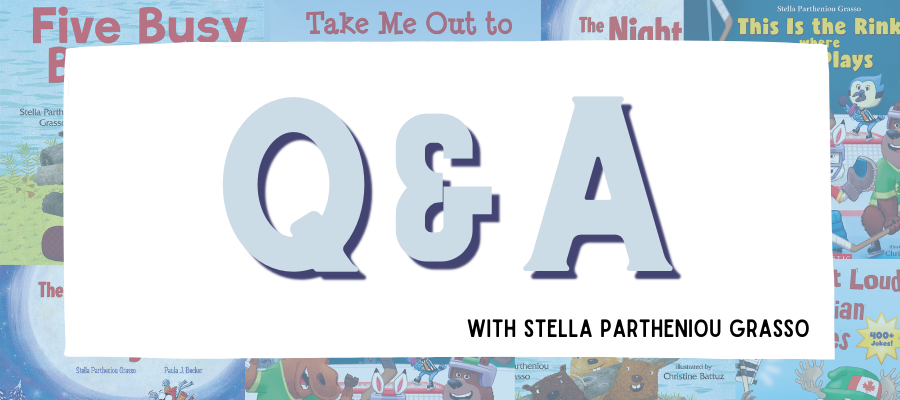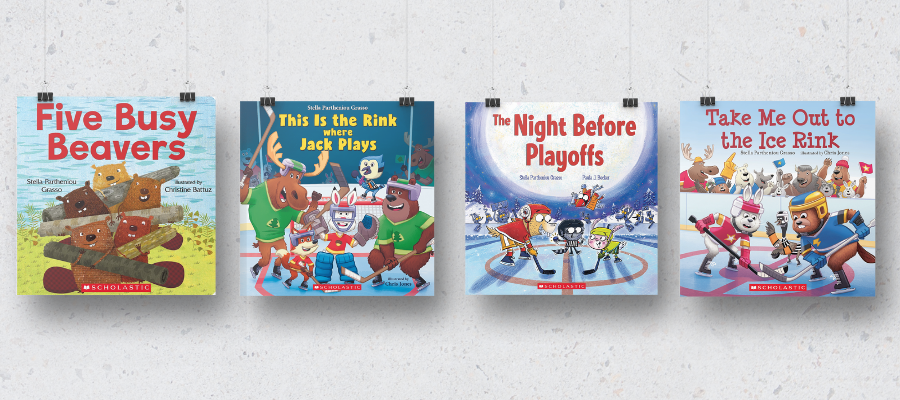Stella Partheniou Grasso has worked in children’s publishing since 2003 and has published several of her own children’s picture books. However, only a couple of years prior to pursuing this industry, a career in publishing wasn’t initially on her radar. As she was finishing her undergrad degree in English and Classical Studies at Trent University, her vision of becoming a teacher no longer felt right and she says that she did not see a clear direction for her career.
That is until one of her English Professors invited her to take photos at a conference honouring Timothy “Tiff” Findley, a Canadian novelist. “During the reception, I met Cynthia Good, Tiff’s publisher. She and I got to talking, and she recommended that I consider a career in publishing. I hadn’t really even considered publishing until I spoke with her. I loved storytelling but never thought it was something that I could be a part of,” she says.
At that time, Stella explains that there were only three publishing programs in Canada, including Centennial’s post-graduate program in Publishing – Book, Magazine and Electronic, and it was this program in particular that stood out to her. She shares, “Centennial’s one-year program offered a robust curriculum. I loved that Centennial provided a practical and structured overview of the industry and I was really interested in the internship component of the course. It was the perfect fit for someone like me who needed to figure out how I fit into the industry.” From there, Stella enrolled and later graduated from the program in 1999, equipped for her future career in publishing.
“I didn’t know a lot about publishing before I started the program. Like most of the students, I associated publishing with editing. By studying all the different careers within the publishing industry, I gained an appreciation for the complexity of the process and the actual business of making books. The program taught me that there are a lot of different ways to express creativity. My career has taken me down a very specific path but I couldn’t have gotten where I am today without the strong foundation I developed at Centennial,” she says.
Fast-forward to 2003, Stella began working at Scholastic Canada as the Publishing Coordinator but shares that the scope of her job expanded as she obtained new skills and tackled new challenges. “I’m now the Publishing Project Manager. My job as publishing project manager didn’t exist before. Rather, it’s something I carved out by taking advantage of learning opportunities and always looking for ways to improve existing processes and communication,” she adds.
Within this role, Stella covers several areas of the business side of publishing. “Primarily I manage the publishing schedules and find ways of making sure the projects we undertake are viable. A lot of my job is communicating between the publishing division and our marketing teams (Trade, Book Clubs, Book Fairs). I often have to liaise with our French team and our manufacturing group. I interact with supply chain, finance.” She is also on the advisory board for Scholastic’s Master Data Management system, in which she explains board members “work together to maintain internal and public-facing information about our books, our authors and illustrators.”

Q. WHAT WAS INVOLVED IN YOUR JOURNEY TO PUBLISHING YOUR FIRST BOOK AND WHAT MOTIVATED YOU TO WRITE IT?
Growing up, my parents told me stories all the time. We came to Canada as refugees when I was a baby so village stories were our way of staying connected to our roots and the family we left behind. As a kid, I would make up spontaneous stories to entertain my younger cousins at family gatherings. In that sense, storytelling was ingrained in me early on but I hadn’t realized it yet. I never really knew that I could be an author or storyteller, but apparently my Grade 4 teacher Mr. VanLoon told my parents to encourage my writing.
Picture books have always held a special place in my heart. I love the way words and images work together to tell a story. Writing for kids aged 3 to 6 can be very challenging. Most picture books are less than 500 words and yet a talented author like Ted Staunton or Ruth Ohi can build an entire world and tell a story in such an economic way. My stories are rhyming texts, which makes writing a bit more of a challenge. By setting up these parameters writing almost turns into a game. Can I create something fun that fits into the constraints of the form I’ve chosen?
The first book I wrote was 101 Creepy Canadian Jokes. It all started as I was walking to work one day. The word “Sasquatchewan” popped into my head. What on earth is “Sasquatchwan” I wondered? It must be where Big Foot lives. And so, I had come up with my first joke. Eventually, I ended up with about 150 jokes and a few silly poems with a spooky theme, so I showed them to the publisher of Scholastic Canada where I worked. She liked them and presented the project to the group. I loved working on that book, although I thought of myself as a writer, not an author. This was just having fun with words; it wasn’t actual storytelling.
My first picture book came a couple of years later. It was Over at the Rink: A Hockey Counting Book. I was tending to a family member in the hospital one February. It was a high-stress time and we were at the hospital 24 hours a day for six weeks. One night I was reciting “Over in the Meadow” as a way of taking my mind off of my family member’s illness. It was snowing pretty hard and I started to think about a winter version. I changed the animals to people and set it at a community rink. What I ended up with was a story about a community rallying together to have a good time.
Thinking back, I wonder if wanting to write about a tight-knit community was informed by all the support my family received from the hospital staff, nurses and doctors who were working together to help my family member.
Most of my published stories are hockey-themed adaptations of classic children’s poems and songs. I’m drawn to that genre because it’s a great way to celebrate themes of community and teamwork. Those same themes appear in Five Busy Beavers, and in many of my unpublished stories as well.
Q. WHAT ARE SOME OF YOUR FAVORITE PARTS ABOUT WRITING CHILDREN’S PICTURE BOOKS AND ABOUT THE INDUSTRY AS A WHOLE?
Getting a draft of a manuscript into shape so that I can send it out for consideration is solitary work and very slow going. I might have a spark of an idea but then I need to go and research the topic before I can even piece a story together. There are a lot of false starts and it can be very discouraging. Rejection is part of the course of being a writer but what keeps me from putting down my pen is that moment when my story makes a connection with another person.
The real fun of writing begins when the story is accepted for publication. I’ve worked with some very talented editors who know just what questions to ask to help me refine my story even further. I love working with someone who is just as invested in the story as I am. Picture books develop even more depth once the illustrator is involved.
I avoid providing illustration notes with my text. I figure I’ve had my fun constructing the words, now it’s time for the illustrator to use their talent and instincts to build on what I’ve provided. It’s always a surprise to see how an illustrator imagines the characters and to see their unique personalities portrayed visually. With picture books, the inspiration flows both ways. There have been times when the illustrations are so amazing that they inspire me to revisit the words. Ultimately, working with an editor, designer and illustrator bring so much to the story that I could never have delivered on my own.
Working in publishing is a very similar experience. Again, harkening back to what I learned at Centennial, everyone involved in a project brings their own skills and passion to it. I work with so many talented people and I love learning from my colleagues.
Q. WHAT IS YOUR ADVICE FOR SOMEONE STARTING OUT IN THE PUBLISHING INDUSTRY AND WHO WANTS TO FOLLOW A SIMILAR CAREER PATH AS YOU?
Feel free to ask questions. I love when someone asks me a thoughtful question. I love when a question stumps me because it means that someone has a new take on an issue and it’s an opportunity to look at a process from a different perspective. This industry is changing at a very quick pace. Asking questions keeps everyone on their toes and helps the industry move forward.
Find something to love about what you are doing. My first job in publishing wasn’t my dream job. When I decided to enter publishing, I knew I wanted to work with children’s books but my first job was adult non-fiction. In many ways, it was a dead-end job for me. I knew I wasn’t going to be at that company forever, but I still made sure to find a way to enjoy my time there. I used that opportunity to gain skills that I could then transfer into a position that was a better fit for me.
Get involved with the community. Be sure to attend industry events like the FOLD, the International Festival of Authors, Telling Tales and Word on the Street. Creativity inspires creativity. That’s one of the things I’m looking forward to about the Toronto International Storytelling Festival. Sure, I’m there for the stories like everyone else but I’m also there to see these professionals at work and to learn from them.
Keep learning and updating your skills. BookNet Canada hosts a lot of webinars and podcasts on a variety of topics that specifically cater to the Canadian market. BISG offers sessions with a North American perspective. Make sure your skills keep pace with the changes in the industry.

Stella recently took part in the 43rd annual Toronto International Storytelling Festival with an event called Beaver Tales, which featured a re-telling from her book, Five Busy Beavers. Currently, she has been working on a more personal project – “Right now I’m focusing on developing some personal stories based on my family’s experiences during the 1974 Turkish invasion of Cyprus to be shared orally. I also have a book of traditional Greek-Cypriot folktales that I’m translating into English so I can adapt them for an English-speaking audience. That’s taken me down some interesting rabbit holes about linguistics and theories of translation.
Greek myths are a big well of inspiration. I’ve developed a story about Medusa’s life before and after her transformation into a monster. I’d like to follow that up with a story about her life in exile, her death and the adventures that follow. Nature also inspires me. I have a few manuscripts set in woodlands that are still works in progress,” she shares.
Article by: Alexandra Few
To read more grad profiles and uncover other great stories happening around the Story Arts Centre campus, check out the latest edition of our Storyteller newsletter.
